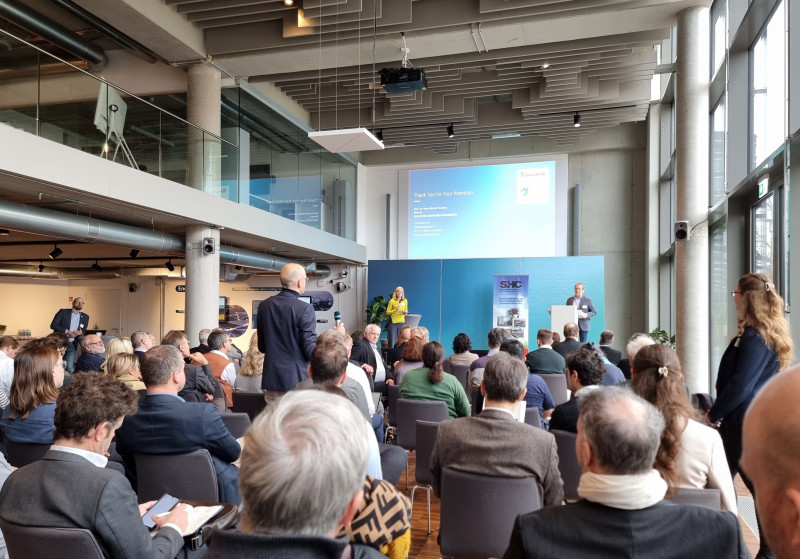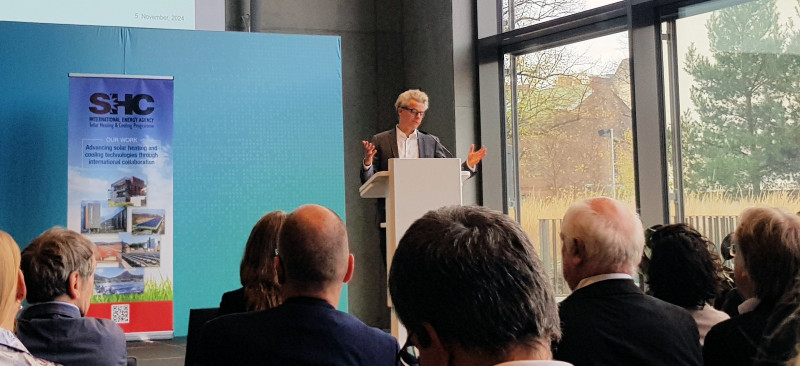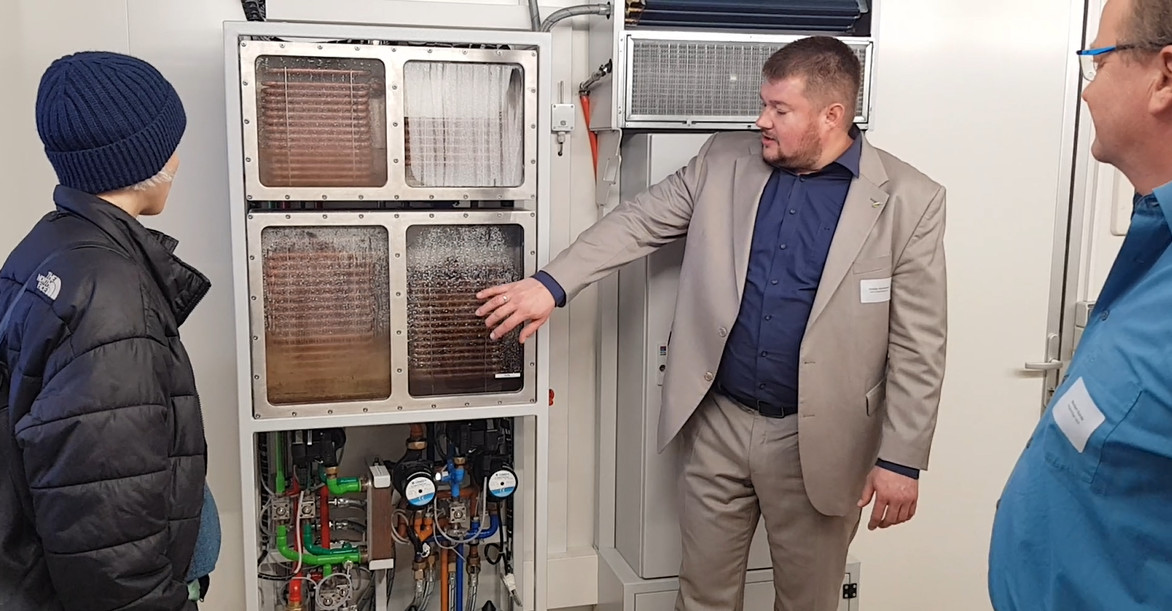Posted: November 16, 2024

Photo: project sponsor Jülich
At the German National Day at the beginning of November entitled “Solar Technology for the Future”, the heat experts clearly pointed out the huge gap that currently exists between long-term potential studies and the actual market development of solar heat technologies. They made clear and precise demands to policy makers for better framework conditions. The two German representatives of the IEA Solar Heating and Cooling Programme, Kerstin Krüger and Dr Daniela Rolf, organized the National Day, which also offered a deep dive into important fields of application: solar district heating and solar process heat. The photo shows Prof. Dr. Hans-Martin Henning, Director of the Fraunhofer ISE, during the Q&A session after presenting the latest results from the study “Paths to a climate-neutral energy system”
"The packed hall demonstrated the great interest in the question of how solar heat can support the decarbonization of the German heat sector", said Krüger. “The composition of the speakers on the agenda, with internationally active IEA SHC experts and German industry and association representatives, offered a good mix with something new for all participants.”
Several speakers highlighted the huge potential that solar heat has for the energy transition.
Hans-Martin Henning, for example, illustrated the latest results for solar heat from simulations with REMod, a national energy model that analyses cost-effective paths towards carbon neutrality in 2045. In four different scenarios, solar heat contributes between 27 and 40 TWh to overall heat production by 2045. At the end of 2023, German solar thermal systems supplied 9.3 TWh according to BSW Solar statistics. This means that three to four times more collector area will need to be installed over the next 20 years than has been the case to date.
However, market figures from BSW Solar show the opposite trend. The new collector area installed each year is not sufficient to compensate for the collectors that have been decommissioned due to age. This means that the total collector area in operation in Germany is decreasing instead of increasing.
“The discussions about the national subsidy scheme for efficient Buildings (BEG) have unsettled homeowners and paradoxically have given gas boilers a boost”, complained Juliane Hinsch from the German association BSW Solar. “Research, industry and politics must work together to develop growth opportunities for solar heat solutions.”
Solar district heating: accelerating the authorization process
Germany is the European leader in solar district heating. In terms of newly installed capacity in 2023, Germany was number two worldwide after China according to the report Solar Heat Worldwide. At the National Day the SDH solar project developer Ritter XL Solar reported on the construction of what will become the largest solar district heating system in Germany: a 41 MWth vacuum tube field for the city of Leipzig, which is scheduled to go into operation in 2026 and is then expected to achieve a solar fraction of 1.6 %.
The German SDH market is developing dynamically, reported Magdalena Berberich from Solites. While 58 SDH plants with a capacity of 114 MWth have been commissioned in the last 20 years, 12 plants totalling 100 MWth are currently being realized. “We should work to accelerate the authorization process”, demanded Berberich, as project development times are still far too long.
She quoted targets from the report Climate Neutral Germany 2045 from the consultancy Prognos. According to this, collector fields are expected to feed in 13 TWh into heat networks by 2045. This corresponds to 30 million m2 of collector area (21 GWth), assuming a specific yield of 433 kWh/m2. This is an extremely ambitious increase compared to the 114 MWth currently in operation.

Christian Maaß, Department Head at the German Federal Ministry for Economic Affairs and Climate Action
Photo: Bärbel Epp
Heat transition plans are a mindset shift
The biggest challenge for the German district heating sector is the requirement to create a heat transition plan. “It is more cost effective to decarbonize heat grids than individual heating systems, which is why we need heat transition plans”, explained Christian Maaß, Head of the Department for Heat, Hydrogen and Efficiency at the Federal Ministry for Economic Affairs and Climate Action (see photo above). The national Heat Planning Law has been in force since January 2024. It requires municipalities with a population of over 100,000 to develop a heat transition plan by June 2026 that describes the path to climate neutrality. Municipalities with fewer than 100,000 inhabitants have until June 2028.
“This is a shift in the mindset, because until now it was left to building owners to decide on the most favourable CO2 reducing heating solution. Now municipalities must support building owners in this decision”, said Maaß. Another important starting point for successful heat transition is the “awareness that we will have to change infrastructure”. It is indeed a problem, according to Maaß, that “a lot of people are convinced that we can just make the gas green and leave all the infrastructure the same."
Solar process heat: rapid depreciation reduces payback period
The biggest gap between potential and real market development in Germany is in the segment of solar process heat. So far, solar industrial heat systems totalling 48,172 m2 have been installed countrywide, a large proportion of them for solar drying. Felix Pag from the University of Kassel highlighted the results of a potential study forecasting 20 TWh of solar heat contribution for industry. Potentially 50 million m2 of collector area would be necessary to cover that demand.
Pag underlined the fact that solar process heat solutions are flexible in terms of integration and typically contribute to optimizing energy efficiency. To speed up deployment rates the researcher suggested two important measures: subsidizing feasibility studies and implementing faster depreciation.
“You can't give enough subsidies to ensure that the payback period for a solar process heat plant is perhaps only three years, which is what industry is demanding", stressed Prof Klaus Vajen from the University of Kassel . He calls for very rapid depreciation because that has an extraordinarily positive effect on the payback period.

The Green Chiller Association offered a tour around the sorption classroom on wheels during the breaks at the National Day. This mobile classroom has been in use for a year and can be requested as a practical unit in vocational schools teaching refrigeration technology and for lectures at university, for example. A completely open absorption cooling system makes it possible to explain the technology clearly and illustrate various operating states. In the picture, Christian Kemmerzehl, Managing Director of EAW Energieanlagenbau, demonstrates the unique system.
Photo: Bärbel Epp
Websites of organizations and publications mentioned in this news article: